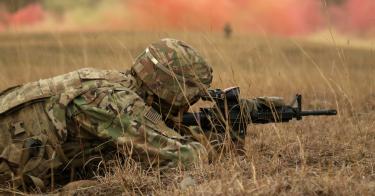The GDRP is a joint program in which U.S. Army advises, mentor and train Georgian personnel and commanders in order to improve combat readiness. (U.S. Army National Guard photo by , 382nd Public Affairs Detachment/ 1st ABCT, 1st CD/Released)
The word “incongruous” immediately came to mind last week when two news headlines appeared at about the same time concerning the U.S. Army.
The Army Times last week reported that at the end of fiscal year 2022 (on Sept. 30), the Army came up 20,000 soldiers short of its authorized end strength.
The Army was authorized to have a strength of 485,000 active-duty soldiers in 2022, but because of severe recruiting challenges, instead ended the year at 465,600. This is a bona fide crisis because a shortfall like this has never been seen in the modern Army, and if it continues, it will result in a greatly diminished force.
Similar challenges are being seen in the Army National Guard and Army Reserve.
The second news headline, appearing that same day, trumpeted the news of the Army releasing its new implementation plan for its climate strategy. Declaring climate change an “immediate and serious threat to U.S. national security,” the 50-page plan detailed all the methods the Army will use to fight climate change, including the application of hundreds of millions of dollars to build microgrids, greenhouse gas-free power plants, and fielding a 100% zero-emission nontactical vehicle fleet by 2027.
Reinforcing the message, Army leaders simultaneously appeared at a think tank event to herald the wisdom of the climate plan.
The same week that the Army fails to achieve its recruiting goal—a direct measure of its health—it released a major news announcement trumpeting the release of its climate change remediation plan. The climate plan, clearly the result of months of arduous work, represents an incredible amount of organizational effort.
That’s effort that to an outside observer seemingly should have been first applied to its current recruiting crisis, as opposed to the direction to establish climate-related training programs, mandates to use only sustainable building materials, and experiments to make tactical vehicles (howitzers and armored personnel carriers) all electric.
Perhaps we should take comfort in the knowledge that while the Army plummets in size and capacity, what is left will at least be producing less carbon dioxide.
Granted, the individuals who produce “climate change implementation plans” are not the same ones who would develop strategies and plans to turn around dwindling recruiting numbers. But planners are planners, and the skills they use to write a climate change plan could reasonably be applied to the recruiting crisis.
It’s about priorities. It’s also about optics. A popular saying nowadays is “read the room.” That doesn’t seem to be happening.
At the time when the Army most needs the support of the nation to persuade young people to join its ranks, it is busy releasing climate strategies. What message does that send?
While the Army didn’t have any choice whether to produce a climate plan (it was required by President Joe Biden’s executive order), the contents of the plan are the Army’s, and some reflect a prioritization of climate ideology over warfighting skills.
The Army’s plan, among other things, contains the requirement to modify unit designs to account for soldiers and civilians that hold “approved climate credentials.”
There is direction to incorporate climate change into “strategic and operational-level wargame and exercise designs.” And the most damning of all is a requirement to “ … produce a digital handbook of potential unit-level collective training modifications that would reduce direct Army [greenhouse gas] emissions.”
Reading between the lines, the Army is considering modifying its unit training programs to reduce greenhouse gases.
A changing climate has always been a challenge the military has had to confront in planning and carrying out its mission. But a consistent failure by the Army to meet its recruiting targets carries dire national security consequences—not sometime in the distant future, but today.
Building a strong national defense is a deadly serious endeavor, one that demands a narrow focus on a few key priorities. That appeared to be missing last week.
This piece originally appeared in The Daily Signal



